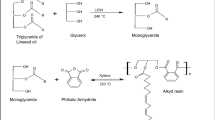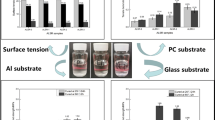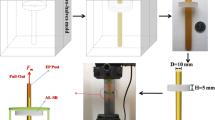Abstract
To bond untreated polyethylene terephthalate (PET) substrate, a novel UV-/moisture-curable silicone-modified poly(urethane–acrylate) (SiPUA) oligomer was synthesized from isophorone diisocyanate (IPDI), hydroxypropyl silicone oil, 2-hydroxyethyl methacrylate (HEMA), and other additives, and the structure of synthesized oligomer was characterized by Fourier transform infrared (FTIR). Adhesive formulas were developed using the synthesized oligomer, N,N-dimethylacrylamide (DMAA), tetrahydro furfuryl alcohol (THFA) and active amine acted as reactive diluents; 1-hydroxy-cyclohexylphenyl-ketone (C-184) and benzophenone (BP) acted as photoinitiators; dehydrating agent, defoamer, flow agent and nanometer inorganic filler acted as additives. The compositions that can be cured by exposure to ultraviolet and also has capability of curing by exposure to moisture at room temperature showed high adhesion to PET substrate. Furthermore, to obtain higher bonding strength to PET substrate, optimal content of curing agent was researched. It was found that appropriate addition of curing agent to the UV-/moisture-curing formula contributed to a remarkable enhancement in adhesion strength, and the shear strength bonding PET substrate can reach 7 MPa in accordance with ASTM D1002. The degree of wetting and fracture surfaces of the bonded joints were analyzed by means of contact angle measurements, scanning electron microscope (SEM), respectively. Mechanic performance tests including lap shear strength, peel strength, adhesion, and hardness were also carried out.








Similar content being viewed by others
References
Decker C (1998) The use of UV irradiation in polymerization. Polym Int 45:133–141
Decker C (2002) Kinetic study and new applications of UV radiation curing. Macromol Rapid Commun 23:1067–1093
Schmidt LE, Yi S, Jin YH, Leterrier Y, Cho YH, Månson JAE (2008) Acrylated hyperbranched polymer photoresist for ultra-thick and low-stress high aspect ratio micropatterns. J Micromech Microeng 18:1–8
Liu HB, Chen MC, Huang ZT, Xu K, Zhang XJ (2004) The influence of silicon-containing acrylate as active diluent on the properties of UV-cured epoxydiacrylate films. Eur Polym J 40:609–613
Lee JH, Prud’Homme RK, Aksay IA (2001) Cure depth in photopolymerization: experiments and theory. J Mater Res 16:3536–3544
Tey JN, Soutar AM, Priyadarshi A, Mhaisalkar SG, Hew KM (2007) Ink and moisture sorption study in UV-curable polyurethane acrylate. J Appl Polym Sci 103:1985–1991
Ha CS, Jung SJ, Kim ES, Kim WS, Lee SJ, Cho WJ (1996) Properties of UV-curable polyurethane acrylates using nonyellowing polyisocyanate for floor coating. J Appl Polym Sci 62:1011–1021
Kim BK, Lee KH, Kim HD (1996) Preparation and properties of UV-curable polyurethane acrylates. J Appl Polym Sci 60:799–805
Athawale VD, Kulkarni MA (2009) Preparation and properties of urethane/acrylate composite by emulsion polymerization technique. Prog Org Coat 65:392–400
Tanoue N, Koishi Y, Atsuta M, Matsumura H (2003) Properties of dual-curable luting composites polymerized with single and dual curing modes. J Oral Rehabil 30:1015–1021
Cho JD, Kim HK, Kim YS, Hong JW (2003) Dual curing of cationic UV-curable clear and pigmented coating systems photosensitized by thioxanthone and anthracene. Polym Test 22:633–645
Qi YS, Yang JW, Zeng ZH, Liao ZF, Chen YL (2005) Novel reactive diluents for UV/moisture dual-curable coatings. J Appl Polym Sci 98:1500–1504
Mallakpour S, Javadpour M (2017) Host recycled poly (ethylene terephthalate) and guest PVA-grafted ZnO nanoparticles: prepared nanocomposites characterization. Polym Bull. https://doi.org/10.1007/s00289-017-2120-1
Bae KY, Lim DH, Park JW, Kim HJ, Jeong HM, Takemura A (2013) Adhesion performance and surface characteristics of low surface energy PSAs fluorinated by UV polymerization. Polym Eng Sci 53:1968–1978
Sonnenschein MF, Webb SP, Cieslinski RC, Wendt BL (2007) Poly (acrylate/epoxy) hybrid adhesives for low-surface-energy plastic adhesion. J Polym Sci Pol Chem 45:989–998
Zhang D, Sun Q, Wadsworth LC (1998) Mechanism of corona treatment on polyolefin films. Polym Eng Sci 38:965–970
Drnovska H, Lapcik L, Bursikova V, Zemek J, Barros-Timmons AM (2003) Surface properties of polyethylene after low-temperature plasma treatment. Colloid Polym Sci 281:1025–1033
Zhang MC, Kang ET, Neoha KG, Han HS, Tan KL (1999) Thermal graft copolymerization with concurrent lamination of low density polyethylene and poly (tetrafluoroethylene) films. Polymer 40:299–305
Mercx FPM, Benzina A, Van Langeveld AD, Lemstra PJ (1993) Improved adhesive properties of high-modulus polyethylene structures. J Mater Sci 28:753–759
Yang J, Garton A (1993) Primers for adhesive bonding to polyolefins. J Appl Polym Sci 48:359–370
Kim PS, Lee SW, Park JW, Park CH, Kim HJ (2013) Kinetic and characterization of UV-curable silicone urethane methacrylate in semi-IPN-structured acrylic PSAs. J Adhes Sci Technol 27:1866–1872
Antosik AK, Bednarczyk P, Czech Z (2017) Aging of silicone pressure-sensitive adhesives. Polym Bull. https://doi.org/10.1007/s00289-017-2083-2
Bi Y, Li Z, Wang N, Zhang L (2016) Preparation and characterization of UV/thermal dual-curable polyurethane acrylate adhesive for inertial confinement fusion experiment. Int J Adhes Adhes 66:9–14
Lin YH, Liao KH, Chou NK, Wang SS, Chu SH, Hsieh KH (2008) UV-curable low-surface-energy fluorinated poly(urethane–acrylate)s for biomedical applications. Eur Polym J 44:2927–2937
Kwok DY, Neumann AW (1999) Contact angle measurement and contact angle interpretation. Adv Colloid Interface 3:167–249
Joo HS, Park YJ, Do HS, Kim HJ, Song SY, Choi KY (2007) The curing performance of UV-curable semi-interpenetrating polymer network structured acrylic pressure-sensitive adhesives. J Adhes Sci Technol 21:575–588
Karasu F, Croutxé-Barghorn C, Allonas X, Ven L (2014) Free radical photopolymerization initiated by UV and LED: towards UV stabilized, tack free coatings. J Polym Sci Pol Chem 52:3597–3607
Hao JQ, Osamu H (2001) UV curable silicone adhesive for difficult to bond materials. Rad Tech Asia 2001-Proceedings of the 8th International Conference on Radiation Curing
Li MR, Zheng Z, Liu SJ, Su YZ, Wei W, Wang XL (2012) Polyurethane (urea)/polyacrylates interpenetrating polymer network (IPN) adhesives for low surface energy materials. Polym Adv Technol 23:1077–1083
Chun JH, Cheon JM, Jeong BY, Jo NJ (2016) The effect of 3-isocyanato-1-propene on adhesive properties of UV-curing urethane/siloxane acrylate resin. J Nanosci Nanotechnol 3:2687–2691
Yu X, Nagarajan MR, Li C, Speckhard TA, Cooper SL (1985) Properties of ultraviolet cured polydimethylsiloxane–urea acrylates. J Appl Polym Sci 30:2115–2135
Tutunchi A, Kamali R, Kianvash A (2016) Effect of Al2O3 nanoparticles on the steel-glass/epoxy composite joint bonded by a two-component structural acrylic adhesive. Soft Mater 14:1–8
Acknowledgements
This work was supported by the Natural Science Foundation of Jiangsu Province (No. BK20131358), the Aeronautical Science Foundation of China (Nos. 2011ZF52063 and 2014ZF52069), and A Project Funded by the Priority Academic Program Development of Jiangsu Higher Education Institutions (PAPD).
Author information
Authors and Affiliations
Corresponding author
Rights and permissions
About this article
Cite this article
Ge, RK., Wang, JW., Zhang, J. et al. UV-/moisture-curable silicone-modified poly(urethane–acrylate) adhesive for untreated PET substrate. Polym. Bull. 75, 3445–3458 (2018). https://doi.org/10.1007/s00289-017-2221-x
Received:
Revised:
Accepted:
Published:
Issue Date:
DOI: https://doi.org/10.1007/s00289-017-2221-x




